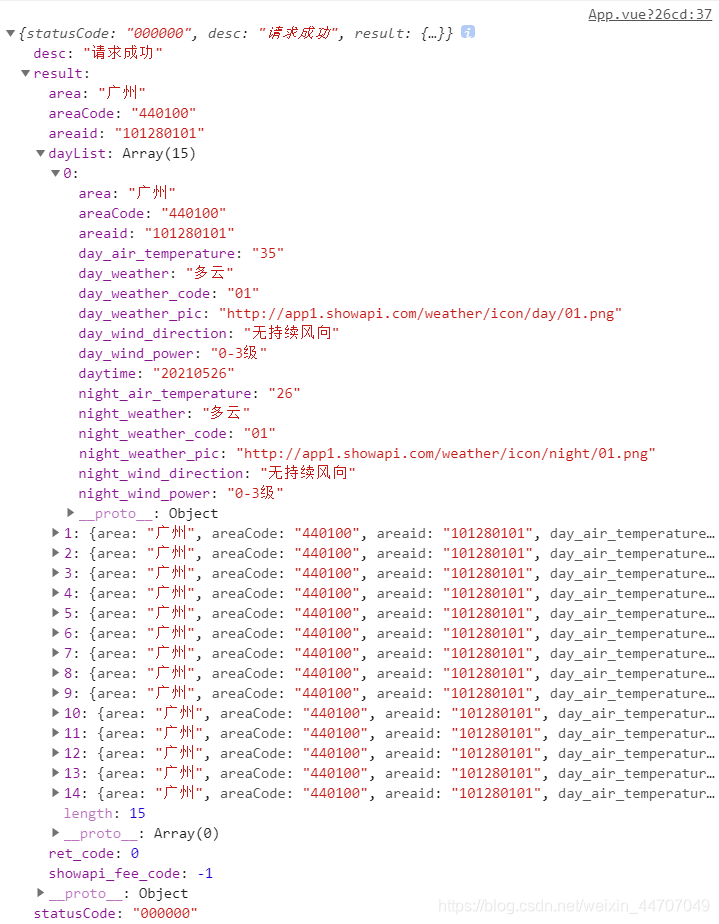【Vue】天气预报功能
axios的教程使用起来挺简单的,看文档再加上实例就能明白了。文档链接点击这里axios的安装进入到项目文件夹下,运行终端,输入npminstallaxios--save,点击回车。a
axios的教程
使用起来挺简单的,看文档再加上实例就能明白了。
文档链接点击这里
axios的安装
进入到项目文件夹下,运行终端,输入npm install axios –save,点击回车。
axios的使用
放入全局的js文件中
<template>
<div class="container-fluid">
<cardtitle :title="cityName" />
<weathertable :weatherlist="WeatherList" :weathersearch="WeatherSeacrh" />
</div>
</template>
<script>
import axios from 'axios' //引入axios
import CardTitle from './components/CardTitle.vue' //引入组件
import WeatherTable from './components/WeatherTable.vue'
export default {
data() {
return {
//通过API获取到的天气数据存放在这个数组里面
WeatherList: [],
cityName:'广州'//默认显示广州的天气
}
},
components: {
cardtitle: CardTitle,//将组件映射为标签
weathertable: WeatherTable
},
mounted() { //生命周期钩子
this.WeatherSearch('广州');
},
methods: {
WeatherSeacrh(cityName) {
const url =
`https://api.apishop.net/common/weather/get15DaysWeatherByArea?apiKey=您自己的apikey&area=${cityName}`;
//使用axios发送ajax请求获取数据
axios.get(url).then(response => {
//请求成功
}).catch(error => {
//请求失败
});//axios-end
},//WeatherSearch-end
},//methods-end
}
</script>
<style>
</style>
先把App.vue组件的基本框架写好。
首先是引入了CardTitle组件和WeatherTable组件,并且将它们映射为标签 <cardtitle /> 和 <weathertable />
然后呢,因为需求中说默认显示广州地区的天气,所以我们用到了生命周期中的mounted钩子,在其中执行我们的查询天气的方法WeatherSearch。
再然后呢,就是 WeatherSearch 方法了,我们在这里面使用了axios发送ajax请求获取数据,里面获取天气的api来自 API Shop,可以自己注册个账号获取自己的apikey,然后替换掉url里面的就行了。
通过查看控制台,我们可以知道返回来的数据格式是这样的:
也就是说,在WeatherSearch方法中,我们要用获取到的数据中的dayList替换掉data中的WeatherList,数据中的area替换掉data中的cityName。现在完善一下 WeatherSearch 方法:
WeatherSeacrh(cityName) {
const url = `https://api.apishop.net/common/weather/get15DaysWeatherByArea?apiKey=您的apikey&area=${cityName}`;
//使用axios发送ajax请求获取数据
axios.get(url).then(
response => {
//请求成功
const dayList = response.data.result.dayList;//天气数据
const area = response.data.result.area;//城市名称
console.log(dayList,area);
//先将WeatherList数组清空
this.WeatherList.length = 0 ;
//将dayList的元素遍历一遍送进WeatherList里面
dayList.forEach((ele,index,arr) => {
this.WeatherList.splice(index,1,ele);
});
//赋值城市名称
this.cityName = area;
}).catch(error => {
alert('请求失败');
});
},
这样App.vue组件就完成了,接着到CardTitle组件
<template>
<div class="row clearfix comment-header">
<div class="col-md-12 column">
<div class="card text-center">
<div class="card-body">
<h1 class="card-title comment-title">{{title}}--天气查询</h1>
</div>
</div>
</div>
</div>
</template>
<script>
export default {
props:{
title: String,
}
}
</script>
<style>
</style>
这个组件比较简单,就是改变标题中的城市的名称。
WeatherTable.vue
<template>
<div class="row clearfix">
<div class="col-md-12 column">
<div class="card">
<div class="card-header text-end">
<input type="search" placeholder="请输入城市名称" v-model="cityname"/>
<button type="button" class="btn btn-primary" @click="Search">查询</button>
</div>
<div class="card-body">
<table class="table table-hover">
<thead>
<tr>
<th scope="col">日期</th>
<th scope="col">日间温度</th>
<th scope="col">晚间温度</th>
<th scope="col">日间天气</th>
<th scope="col">晚间天气</th>
<th scope="col">风向</th>
<th scope="col">风力</th>
</tr>
</thead>
<tbody>
<tr v-for="(ele,i) in weatherlist">
<td>{{ele.daytime}}</td>
<td>{{ele.day_air_temperature}}℃</td>
<td>{{ele.night_air_temperature}}℃</td>
<td>{{ele.day_weather}}</td>
<td>{{ele.night_weather}}</td>
<td>{{ele.day_wind_direction}}</td>
<td>{{ele.day_wind_power}}</td>
</tr>
</tbody>
</table>
</div>
</div>
</div>
</div>
</template>
<script>
export default {
data() {
return {
cityname:''
}
},
props: {
weatherlist: Array,
weathersearch: Function,
},
methods:{
Search(){
const {weathersearch} = this;
weathersearch(this.cityname);
}
}
}
</script>
<style>
</style>
WeatherTable组件有两个自定属性,分别是weatherlist和weathersearch。
weatherlist接收的是用于渲染页面的天气数据的数组。
weathersearch接收的则是用于进行搜索的天气的方法。
到这里,这个实例就已经完成了。
相关文章
发表评论
评论列表
- 这篇文章还没有收到评论,赶紧来抢沙发吧~


